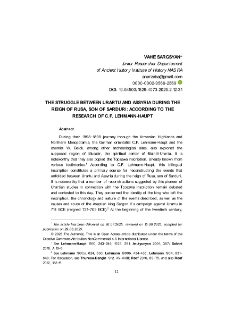Object
Title: The Struggle between Urartu and Assyria during the Reign of Rusa, Son of Sarduri: According to the Research of C. F. Lehmann-Haupt
Publication Details:
«Բանբեր հայագիտության» միջազգային գիտական հանդեսը լույս է տեսնում 2013 թվականից։
Journal or Publication Title:
Բանբեր հայագիտության = Вестник Арменоведения = Review of Armenian studies
Date of publication:
Number:
ISSN:
Official URL:
Additional Information:
Other title:
Contributor(s):
Գլխավոր խմբագիր՝ Պ. Ա. Չոբանյան (2013-2017) ; Ա. Խառատյան (2017-)
Coverage:
Abstract:
During their 1898–1899 journey through the Armenian Highlands and Northern Mesopotamia, the German orientalist C.F. Lehmann-Haupt and the chemist W. Belck, among other archaeological sites, also explored the supposed region of Musasir, the spiritual center of Biainili-Urartu. It is noteworthy that they also copied the Topzawa inscription, already known from various testimonies.1 According to C.F. Lehmann-Haupt, this bilingual inscription constitutes a primary source for reconstructing the events that unfolded between Urartu and Assyria during the reign of Rusa, son of Sarduri. It is noteworthy that a number of reconstructions suggested by this pioneer of Urartian studies in connection with the Topzawa inscription remain debated and contested to this day. They concerned the identity of the king who left the inscription, the chronology and nature of the events described, as well as the causes and route of the Assyrian king Sargon II’s campaign against Urartu in 714 BCE (reigned 721–705 BCE).2 At the beginning of the twentieth century, when C.F. Lehmann-Haupt addressed the route of Sargon II’s campaign in the Urmian basin, the boundaries of Urartu were still unclear, and his hypotheses were largely disregarded.
Հայկական լեռնաշխարհում և Հյուսիսային Միջագետքում 1898–1899 թթ. իրականացրած ճանապարհորդության ժամանակ գերմանացի արևելագետ Կ.Ֆ. Լեման-Հաուպտը և քիմիկոս Վ. Բելքը ընդօրինակեցին Թոփուզավայի երկլեզու արձանագրությունը: Արձանագրության թարգմանությունից հետո Կ.Ֆ. Լեման-Հաուպտն այն իրավացիորեն վերագրեց Ռուսա Սարդուրորդուն: Սույն սկզբնաղբյուրը հետազոտողի համար առանցքային դարձավ Ք.ա. VIII դարի վերջին Ուրարտուի և Ասորեստանի միջև ծավալված իրադարձությունների վերականգնման համար: Կ.Ֆ. Լեման-Հաուպտը Թոփուզավայի արձանագրությունում վկայված իրողություններով է պայ-մանավորում Ք.ա. 714 թ. Սարգոն II-ի արշավանքը Ուրարտու: Ուշագրավ է, որ հետազոտողը ճշգրիտ տեղորոշեց Մուծածիրի վայրը և քննելով Սար-գոն II-ի արշավանքի երթուղին, թեպետ թյուրիմացաբար, այն պատկերացրեց Վանա լճի ավազանով, սակայն արշավանքի վերջին փուլը վերականգ-նեց Ուրմիա լճի ավազանի արևմտյան շրջաններով: Ըստ էության դեռևս XX դարասկզբին Կ․Ֆ․ Լեման-Հաուպտի առաջարկած սույն տարբերակը, բացառությամբ Վանա լճի ավազան ասորեստանյան բանակի մուտքի, հանդիսանում է Սարգոն II-ի արշավանքի երթուղու ցարդ առանցքային քննարկվող վարկած:
Place of publishing:
Երևան
Publisher:
Format:
Identifier:
click here to follow the link ; oai:arar.sci.am:415569
Call number:
Location of original object:
ՀՀ ԳԱԱ Հիմնարար գիտական գրադարան
Object collections:
Last modified:
Oct 6, 2025
In our library since:
Oct 6, 2025
Number of object content hits:
52
All available object's versions:
https://arar.sci.am/publication/449980
Show description in RDF format:
Show description in OAI-PMH format:
-
Բանբեր հայագիտության = Вестник Арменоведения = Review of Armenian studies
-
Բանբեր հայագիտության, 2013
-
Բանբեր հայագիտության, 2014
-
Բանբեր հայագիտության, 2015
-
Բանբեր հայագիտության, 2016
-
Բանբեր հայագիտության, 2017
-
Բանբեր հայագիտության, 2018
-
Բանբեր հայագիտության, 2019
-
Բանբեր հայագիտության, 2020
-
Բանբեր հայագիտության, 2021
-
Բանբեր հայագիտության, 2022
-
Բանբեր հայագիտության, 2023
-
Բանբեր հայագիտության, 2024
-
Բանբեր հայագիտության, 2025
-
Բանբեր հայագիտության, 2025, 1
-
Բանբեր հայագիտության, 2025, 2
- Կազմ; Խմբագրական խորհուրդ; Գիտական խորհուրդ
- Contents
- The Past and Present Languages of the People of Azerbaijan
- The Struggle between Urartu and Assyria during the Reign of Rusa, Son of Sarduri: According to the Research of C. F. Lehmann-Haupt
- Hunchak Figure Tashir (Simon Hovvian): Public and Political Activities, 1915–1921
- The Coverage of Educational and Cultural Issues of the First Republic of Armenia in the Pages of the “Chakatamart” Daily Newspaper (1918–1920)
- The Armenian Genocide in Art, Film, and International Relations
- The Reinterpretation of the History of the Defence Army of the Republic of Artsakh in Armenian Historiography
- Անգեղ Աստվածը հայոց հնագույն դիցաբանության մեջ
- Հայ պատմիչները միջնադարյան Հայաստանում գործածված զենքերի ու սպառազինության մասին
- Manifestations of Genocide Psychotrauma in Andranik Tsarukyan’s Novella “People Without Childhood”
- Karine Khodikyan's Biographical and Creative Profile and the “Two Plays” Collection
- Անառակ որդու վերադարձը կամ՝ Եղիշե Չարենցը Աստծու հայացքի ներքո
- Davit Evereklyan: His Activities In Montreal
- A Collection Dedicated to the Works of Perch Terzian
- A View from the Outside: The Collection “The Continuing Paths of Life” as the Living Voice of the Diaspora
- Arshak Safrastian’s report read at the XXI Congress of Orientalists held in Paris
-
Բանբեր հայագիտության, 2025, 1
-
Բանբեր հայագիտության, 2013





